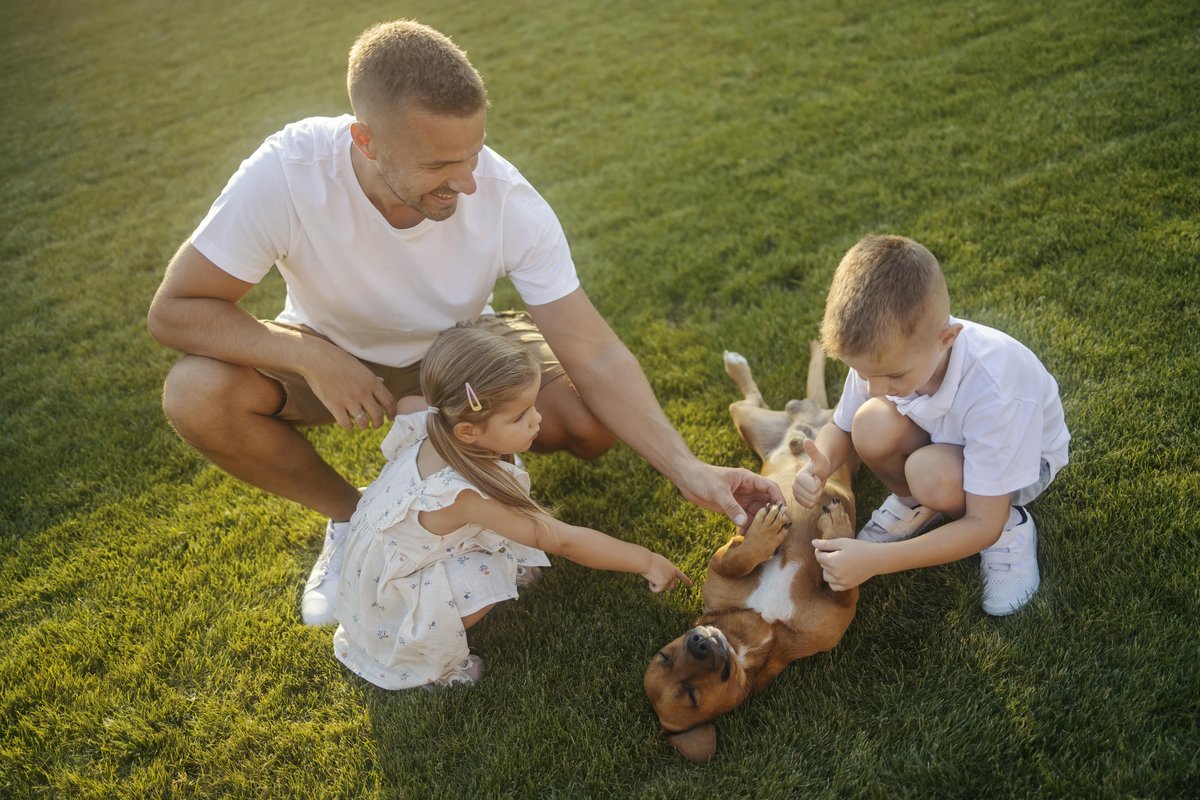You've decided to expand your family with a rescue dog—congratulations! Adopting a pet with kids in the home can be one of the most rewarding experiences for your family. Children who grow up with dogs learn empathy, responsibility, and unconditional love. But let's be honest: adding a four-legged family member when you have kids also comes with unique considerations.
The good news? Thousands of amazing family-friendly dogs are waiting in shelters right now, and with the right preparation, you can find the perfect match for your household. Whether you're adopting a dog with toddlers, tweens, or teens, this guide will walk you through everything you need to know to make your family pet adoption a success.
Why Adopting a Rescue Dog is Perfect for Families with Kids
Before we dive into the how-to, let's talk about why adopting a dog with children is such a great decision. Studies show that kids who grow up with pets develop stronger immune systems, have lower stress levels, and show increased emotional intelligence. Plus, caring for a rescue dog teaches children about compassion and second chances.
Many families worry that shelter dogs might not be good with kids, but the truth is quite the opposite. Shelters and rescue organizations carefully evaluate each dog's temperament and behavior around children. Many dogs in shelters are already experienced with kids from their previous homes, and foster-based rescues can provide detailed information about how dogs interact with children of different ages.
Choosing the Best Dog Breeds for Families with Children
When you're adopting a family dog, breed characteristics can give you helpful clues about temperament—but remember, every dog is an individual. The best family dogs typically share certain traits: patience, gentleness, moderate to high energy levels (to keep up with kids!), and a stable, predictable temperament.
Top Family-Friendly Dog Breeds Often Found in Shelters:
Labrador Retrievers and Lab Mixes: Labs are consistently ranked as one of the best dogs for kids. They're patient, playful, loyal, and gentle. Their eager-to-please nature makes them easy to train, which is essential in a household with children. Lab mixes are incredibly common in shelters and offer all the wonderful traits of purebred Labs.
Golden Retrievers and Golden Mixes: Known for their gentle mouths and patient demeanor, Golden Retrievers are naturals with children. They're affectionate, intelligent, and tend to be very tolerant of the noise and activity that comes with kids. Golden mixes in shelters often inherit these family-friendly qualities.
Beagles and Beagle Mixes: These medium-sized dogs are sturdy, playful, and have an even temperament that works well with children. Beagles are pack animals, which means they typically love being part of a busy family. They're also small enough that they won't accidentally knock over young children but big enough to keep up with active play.
Boxers and Boxer Mixes: Boxers are incredibly patient and protective of children, earning them the nickname "nanny dogs." They have high energy levels perfect for active families and form strong bonds with kids. Their playful nature means they'll happily join in backyard games.
Mutts and Mixed Breeds: Don't overlook mixed-breed dogs! Many of the best family pets are wonderful mutts who combine the best traits of multiple breeds. Shelter staff can help you understand a mixed-breed dog's likely temperament based on their behavior and physical characteristics.
Size Matters: Small, Medium, or Large Dogs for Families?
While there are wonderful family dogs of every size, consider your children's ages when thinking about size. Very small dogs (under 15 pounds) can be fragile around toddlers who are still learning gentle touch. Medium to large dogs (30-70 pounds) are often more durable and less likely to be accidentally hurt during play, though they need training not to jump on small children. Giant breeds (over 80 pounds) can be excellent with kids but require extra space and can accidentally knock over toddlers simply by wagging their tails enthusiastically!
Age-Specific Advice: Matching Dogs with Children's Ages
Adopting a Dog with Toddlers and Preschoolers (Ages 1-5)
Young children require extra supervision around any dog, no matter how gentle. For families with toddlers, consider adopting an adult dog (3+ years old) rather than a puppy. Adult dogs are typically calmer, already house-trained, and past the mouthy puppy stage. Look for dogs described as "gentle," "patient," "tolerant," and "low prey drive" in their shelter profiles.
When using the WeRescue app to search for family-friendly dogs, filter for personality traits like "good with kids," "gentle," and "calm." Avoid dogs with descriptions like "high energy," "needs experienced owner," or "no young children" if you have toddlers at home.
Red flags to watch for: Dogs who show resource guarding (protective over food or toys), have a history of snapping when startled, or display anxiety around loud noises may not be the best match for homes with very young children.
Adopting a Dog with Elementary-Age Kids (Ages 6-10)
This is often the sweet spot for family dog adoption! Elementary-age children are old enough to learn how to properly interact with dogs but young enough to grow up alongside a pet. They can start taking on age-appropriate responsibilities like filling water bowls, helping with feeding under supervision, and practicing basic training commands.
For this age group, you have more flexibility. Both adult dogs and adolescent dogs (1-3 years old) can work beautifully. More energetic dogs who love to play fetch, go for walks, and engage in activities are excellent matches for active kids. Look for dogs described as "playful," "loves kids," "energetic," and "friendly."
Adopting a Dog with Tweens and Teens (Ages 11+)
Older children can handle more responsibility and can actively participate in training, walking, and caring for a family dog. This is a great time to involve kids in the entire adoption process, from searching on WeRescue to visiting shelters to making the final decision together.
Teens often do well with higher-energy dogs who need regular exercise, as they can take on walking duties. This age group can also help with training more challenging behaviors, making them good candidates for adopting dogs who might need a little extra patience or structure. Consider involving your teen in obedience classes—it's a great bonding activity and teaches both the dog and the young person important skills.
Using WeRescue to Find the Perfect Family Dog
The WeRescue app makes finding child-friendly rescue dogs easier than ever. Here's how to optimize your search for family pet adoption:
Start with the right filters: Open the WeRescue app and use the advanced search filters to narrow your results. Filter by "good with kids" under personality traits. You can also filter by age (adult dogs are often calmer), size, and distance from your home.
Read between the lines: Pay close attention to the personality descriptions in each dog's profile. Words like "gentle giant," "loves everyone," "patient," "tolerant," and "family-oriented" are great signs. Dogs described as "best as only pet," "needs quiet home," or "shy around children" may need a different living situation.
Look for foster-based rescues: Dogs in foster homes often come with detailed information about their behavior around children because they've been living in home environments. Foster families can tell you if the dog is gentle when kids are eating snacks, how they react to crying or loud play, and whether they've been around children of specific ages.
Save your favorites: As you browse, save multiple dogs that seem like good matches. This gives you options and allows you to reach out to several shelters. With WeRescue's save feature, you can easily compare different dogs and revisit profiles as you make your decision.
Set up alerts: Use WeRescue's notification features to get alerts when new family-friendly dogs matching your criteria become available. Great family dogs get adopted quickly, so being among the first to know can make all the difference.
Questions to Ask the Shelter Before Adopting a Dog with Kids
When you've found a dog you're interested in, these questions will help you determine if they're truly a good match for your family:
- Has this dog lived with children before? If yes, what ages? How did they interact?
- How does this dog react to quick movements, loud noises, and high-pitched sounds? (All common with kids!)
- Has the dog shown any food or toy guarding behaviors? This is crucial for homes with children.
- What is the dog's energy level? Will they need multiple long walks daily, or are they content with moderate exercise?
- How does this dog do with handling? Will they tolerate occasional tail-pulling or hugging from young children learning boundaries?
- Are there any triggers that startle or scare this dog? Knowing this helps you create a calm environment.
- What is the dog's bite history, if any? Reputable shelters will be honest about this important safety information.
- Can we do a meet-and-greet with all family members, including children? This is essential before finalizing any adoption.
Don't be afraid to ask detailed questions! Shelter staff and rescue volunteers want to ensure successful adoptions, and they'd much rather answer thorough questions upfront than see a dog returned because of a mismatch.
Preparing Your Kids for a Rescue Dog
Adopting a family dog isn't just about finding the right dog—it's also about preparing your children to be responsible, respectful pet owners. Here's how to set everyone up for success:
Teaching Children How to Interact with Dogs Safely
Before the dog comes home, teach these essential rules:
- Always ask before petting or approaching a dog (This applies to all dogs, not just yours)
- Never disturb a dog who is eating, sleeping, or in their crate (These are safe spaces)
- Gentle touches only (No pulling ears, tails, or fur; show them how to properly pet a dog)
- Keep your face away from the dog's face (No nose-to-nose greetings or hugging around the neck)
- Calm, quiet voices around the new dog (Especially during the first few weeks)
- Never chase a dog or corner them (Always give dogs an escape route)
- If the dog takes a toy from you, let them have it (No tug-of-war over possessions)
Age-Appropriate Responsibilities for Kids
Involving children in dog care teaches responsibility while building the bond between kid and dog. Here's what different ages can typically handle:
Ages 3-5: Help fill water bowls (with supervision), give treats for good behavior, help brush the dog, participate in playtime
Ages 6-9: All of the above, plus help measure food, practice basic commands with the dog, play fetch in the yard, help with grooming tasks
Ages 10-12: All of the above, plus feed the dog independently, go on supervised walks, clean up the yard, help with basic training
Ages 13+: Can handle most aspects of dog care including walks, feeding, training sessions, and even helping with vet appointments
Remember: while children can help with dog care, parents are ultimately responsible for ensuring the dog's needs are met. Don't rely on promises of "I'll do everything!"—even the most well-intentioned child will need reminders and supervision.
The First Week: Bringing Your Rescue Dog Home with Kids
You've found your perfect family dog through WeRescue, asked all the right questions, and prepared your kids—now it's time to bring your new rescue dog home! The first week is crucial for setting the foundation of your relationship.
Day One: Keep It Calm
Your new dog will be overwhelmed, anxious, and trying to figure out their place in your home. Even dogs who seemed confident at the shelter may be nervous in a new environment. Keep the first day low-key:
- Introduce the dog to one or two family members at a time, not everyone at once
- Let the dog explore the house at their own pace (keep excited kids from following them room-to-room)
- Show the dog where their food, water, bed, and potty area are located
- Postpone the neighborhood welcome party—no visitors for at least the first week
- Stick to quiet activities; save the backyard playtime for after the dog has settled
The "Two-Week Shutdown" Method for Rescue Dogs
Many animal behaviorists recommend a "two-week shutdown" period for rescue dogs, especially those coming from stressful shelter environments. During this time, keep routines predictable, interactions calm, and expectations minimal. This doesn't mean ignoring your new dog—it means giving them space to decompress without overwhelming them with training, socialization, or constant attention.
For families with excited kids, this can be challenging! Explain to your children that the dog needs time to feel safe and that the best gift they can give is patience. Set specific times when kids can interact with the dog (feeding time, short play sessions) and times when the dog gets quiet time.
Establishing Boundaries and House Rules
Before your rescue dog arrives, have a family meeting to establish consistent rules that everyone will follow:
- Where is the dog allowed in the house? (Furniture? Bedrooms? Off-limits areas?)
- Who is responsible for which tasks? (Create a chart for feeding, walking, training)
- What are the commands everyone will use? (Consistency is key for training)
- What time is the dog's bedtime routine?
- How will you handle unwanted behaviors like jumping or barking?
Post these rules somewhere visible so everyone remembers them, especially in those early weeks when you're all adjusting.
Supervise, Supervise, Supervise
This cannot be stressed enough: always supervise interactions between children and your new dog, especially during the first few months. Even the gentlest, most kid-friendly dog needs time to learn your family's routines, quirks, and boundaries. And children, no matter how well-intentioned, can accidentally hurt or startle a dog.
Use baby gates to create separate spaces when you can't actively supervise. Crate training provides your dog with a safe retreat when they need alone time. Teach children that when the dog goes to their crate or bed, they're off-limits—no exceptions.
Red Flags and When to Seek Professional Help
Most family dog adoptions are incredibly successful, but it's important to recognize when you might need extra support. Contact a certified professional dog trainer or veterinary behaviorist if you notice:
- Growling, snapping, or biting directed at children (even if "just a warning")
- Intense resource guarding of food, toys, or spaces
- Excessive fear or anxiety that doesn't improve after several weeks
- Aggression toward other family pets
- Destructive behavior that seems to be worsening
- Severe separation anxiety preventing you from leaving the house
Many of these behaviors can be successfully addressed with professional training, and seeking help early prevents problems from becoming ingrained. Don't feel like you've failed if you need support—responsible pet ownership means recognizing when you need expert guidance.
The Long-Term Benefits: Why It's All Worth It
Yes, adopting a rescue dog with kids requires preparation, patience, and consistency. But the payoff is extraordinary. Children who grow up with dogs develop stronger social skills, higher self-esteem, and a lifelong understanding of compassion and responsibility. They learn that love sometimes means sacrifice—getting up early for walks, sharing space, and putting another creature's needs alongside their own.
For the rescue dog, your family offers a second chance at the happy life they deserve. You're not just adopting a dog; you're saving a life and teaching your children one of life's most important lessons: that every creature deserves love, patience, and a safe home.
The best part? Somewhere in a shelter right now, your perfect family dog is waiting to meet you.
Start Your Family's Adoption Journey Today
Ready to find your family's perfect rescue dog? Download the WeRescue app and start searching over 400,000 adoptable dogs, including thousands of family-friendly pets waiting in shelters across the country. Use our advanced filters to find dogs who are great with kids, and connect directly with shelters and rescue organizations to learn more.
Whether you're adopting with toddlers, teens, or anywhere in between, WeRescue makes it easy to find the right match for your family. Your new best friend is out there—let's help you find them.
Download WeRescue today and start your search for the perfect family dog!






